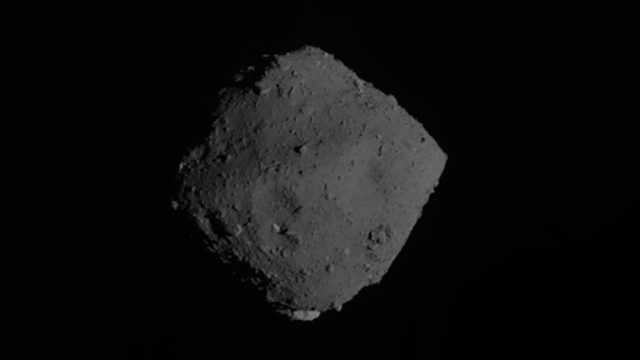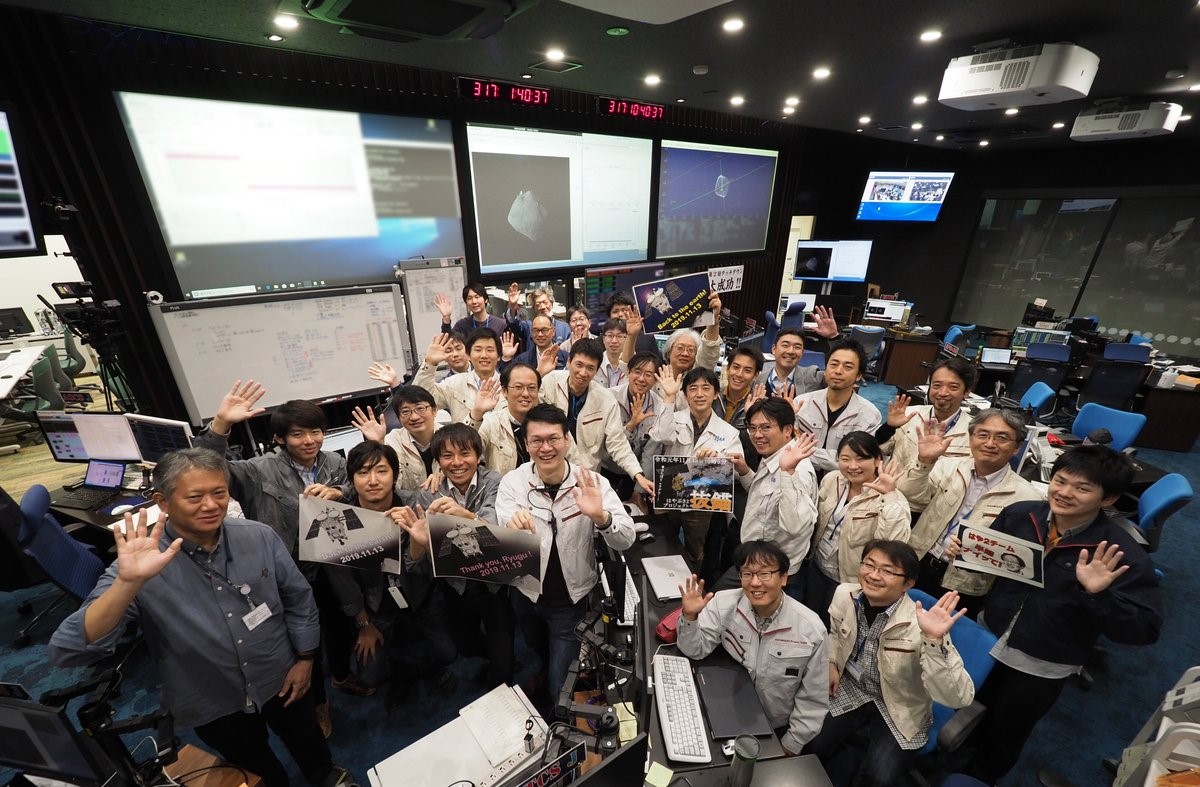Farewell, Ryugu! Japan's Hayabusa2 Probe Leaves Asteroid for Journey Home

Japan's enterprising asteroid-sampling spacecraft began they journey home Tuesday (Nov. 12), packed full of precious space rocks that scientists can't wait to get their hands on.
Mission controllers and with the Japan Aerospace Exploration Agency (JAXA) told the Hayabusa2 spacecraft to turn toward home at 10:05 a.m. local time Nov. 13 (8:05 p.m. EST Nov. 12; 0105 GMT Nov. 13). That command marks the beginning of the last stage of the mission, which launched in December 2014 to explore and sample an asteroid dubbed Ryugu and also included deploying several smaller robots onto the rocky body.
After more than a year packed full of work at the rocky body, mission scientists will now spend a year waiting for the spacecraft's return to Earth. "After the applause, Project Manager [Yuichi] Tsuda murmured a goodbye that sounded both affectionate and a touch lonely," mission personnel wrote on the spacecraft's Twitter.
Related: Japan's Hayabusa2 Drops Target Markers on Asteroid Ryugu
As Hayabusa2 leaves its erstwhile companion, one of the signature activities of the mission will take on a new tone. For months, the spacecraft has beamed home sequences of images showing Ryugu gradually growing larger as the probe approached its target for individual maneuvers. In the navigation-camera images, the asteroid would morph from a grayish pinprick to an intricately rubble-covered world.
Now, that sequence is playing out one final time in reverse, in an imaging campaign dubbed "Goodbye Ryugu." The series is scheduled to last for five days, until Nov. 18 at mission control, with a new image appearing on the mission website every half hour or so for a few hours a day.
[Japan 10:24 JST] At 10:19, a cheer of ‘wow’ rose in the control room. After checking the status of the spacecraft, people rose and applauded. Project Manager Tsuda announced “This is the end of the Near Asteroid Operation Phase!”November 13, 2019
Of the first such image received after Hayabusa2 turned home, JAXA personnel wrote, "This is a familiar sight, but realising that we can't see it soon is sad!"
Get the Space.com Newsletter
Breaking space news, the latest updates on rocket launches, skywatching events and more!
Soon after the image stream stops, the spacecraft will adjust its position and turn on its ion engine in preparation for the long journey back to Earth, which will officially begin on Dec. 3, according to JAXA. (During the first days of departure, the spacecraft is relying on chemical fuel.)
The voyage back to Earth will take the spacecraft about a year. When Hayabusa2 arrives near Earth, it will eject the capsule containing samples gathered from Ryugu. That capsule should touch down in the Australian Outback, the sample place where the mission's predecessor, Hayabusa, deposited its hard-earned grains of asteroid dust.

Hayabusa2 has been a resounding success so far, with the mission having already accomplished all the tasks it wanted to at the asteroid itself. But the mission's long-term legacy will be determined only after JAXA scientists have a chance to study the material inside the return capsule.
That material should include both surface rocks and samples from inside Ryugu, excavated by firing a bullet at the asteroid. Taken together, the samples should help the team understand the history of the rocky body the spacecraft spent so long dancing around.
- Watch Japan's Hayabusa2 Grab a Piece of an Asteroid in This Incredible Video!
- Shadow Selfie! Japanese Asteroid Probe Snaps Amazing Post-Landing Pic
- Japan's Hopping Rovers Capture Amazing Views of Asteroid Ryugu (Video)
Email Meghan Bartels at mbartels@space.com or follow her @meghanbartels. Follow us on Twitter @Spacedotcom and on Facebook.

Join our Space Forums to keep talking space on the latest missions, night sky and more! And if you have a news tip, correction or comment, let us know at: community@space.com.

Meghan is a senior writer at Space.com and has more than five years' experience as a science journalist based in New York City. She joined Space.com in July 2018, with previous writing published in outlets including Newsweek and Audubon. Meghan earned an MA in science journalism from New York University and a BA in classics from Georgetown University, and in her free time she enjoys reading and visiting museums. Follow her on Twitter at @meghanbartels.









